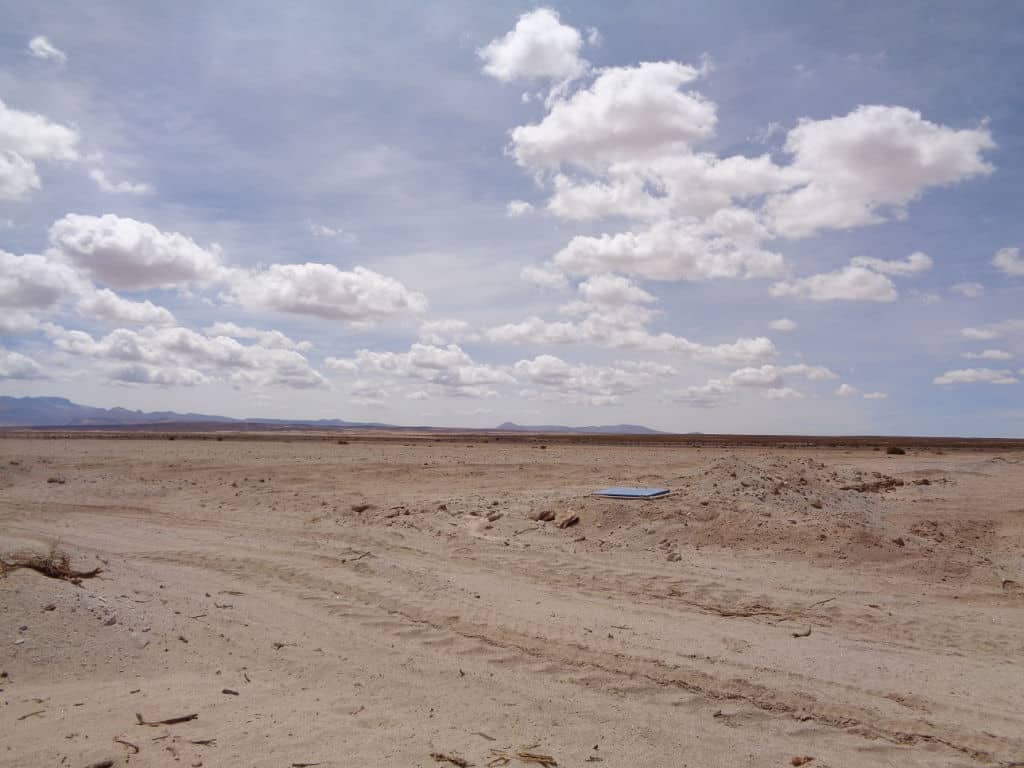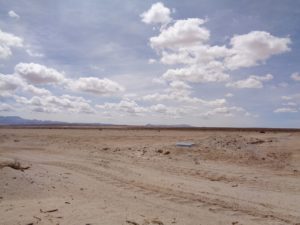 Quinoa production in Bolivia may fall 50% in 2017, according to research conducted at Mercadero. This means that production will drop from 69,000 tons in 2016 to 35,000 tons. Three main factors are pointing to a lower harvest. First, farmers have become demotivated by the continuing low prices they receive for their crop. Second, the drought during the sowing season, normally starting in August, has strongly reduced the area sown with quinoa in the northern and central parts of the Altiplano. And finally, drought and strong winds have severely damaged the crop throughout the entire region. Consequently, the emerging quinoa plants in many parts of the Altiplano have been affected, leading to a much lower expected yield. This will severely impact the livelihood of farmers and also affect the international market, since Bolivia is still the second largest global producer after Peru.
Quinoa production in Bolivia may fall 50% in 2017, according to research conducted at Mercadero. This means that production will drop from 69,000 tons in 2016 to 35,000 tons. Three main factors are pointing to a lower harvest. First, farmers have become demotivated by the continuing low prices they receive for their crop. Second, the drought during the sowing season, normally starting in August, has strongly reduced the area sown with quinoa in the northern and central parts of the Altiplano. And finally, drought and strong winds have severely damaged the crop throughout the entire region. Consequently, the emerging quinoa plants in many parts of the Altiplano have been affected, leading to a much lower expected yield. This will severely impact the livelihood of farmers and also affect the international market, since Bolivia is still the second largest global producer after Peru.
Production volume, cultivated area and yield of quinoa in Bolivia are monitored by the Ministry of Rural Development and Land (Ministerio de Desarrollo Rural y Tierras). These data are generally used as a reference and presented below (Table 1). For 2015-2016, official data have not yet been emitted, but a figure of 69,000 tons of production is widely used in the media. The area harvested for this season has been estimated at 181,472 hectares by Cabolqui (personal communication). If these figures are correct, the yield in 2015-2016 was very low, which is consistent with reports about drought and dust storms during the growing season.
Table 1. Cultivated area, yield and production volume of quinoa in Bolivia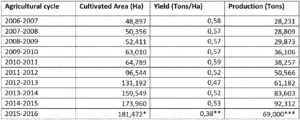 Source: Ministerio de Desarrollo Rural y Tierras, *Cabolqui, personal communication, **Own calculation, ***Media
Source: Ministerio de Desarrollo Rural y Tierras, *Cabolqui, personal communication, **Own calculation, ***Media
After the enormous price hike in 2014, the price dropped to what farmers used to receive for the grain in 2012 and before (Figure 1). The Challapata market is one of the key markets for Bolivian producers to sell their quinoa to traders and exporters. The prices farmers receive on this market have remained stable throughout the year, at 300 to 400 Bolivianos per quintal.1 This is equivalent to 0.94 to 1.26 USD/kg, and is about 75% less than they received mid-2014. The international price continued to decrease as well.
Figure 1. Wholesale Prices for Quinoa in Oruro, 2011 – 2016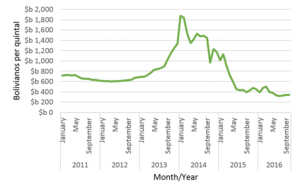 Source: Ministerio de Desarrollo Rural y Tierras
Source: Ministerio de Desarrollo Rural y Tierras
The low prices and the strong competition Bolivia is facing from Peru, have demotivated Bolivian producers to grow quinoa. Waiting for a better payment, they have saved part of the harvest of the agricultural cycle of 2014-2015 in stock. Those farmers who started growing quinoa to benefit from the high world prices, have abandoned their fields on the Altiplano. However, many farmers in this region have been growing quinoa for decades. They do not have many other income generating options. As one of our experts explained: almost nothing else grows under the harsh circumstances of the highlands; mostly infertile grounds in between 4000 and 5000 meters above sea level.
In addition to the effect of the low prices, the weather continues to affect the quinoa production in Bolivia. The current drought is the most extreme in 25 years, according to news articles. Interviews with experts in the region gave us an insight into the extent to which the crop has been damaged so far. Normally, the quinoa in Bolivia is sown between August and December. During the past months, farmers in the northern and central regions of the Altiplano, have been waiting desperately for enough rain to start the new agricultural season. In some areas they have tried to sow despite the minimal rainfall, with varying outcomes: in some fields the quinoa has not sprouted at all, in other regions the plants are growing, although they are much smaller than usual for this time of the year.
In the southern part of the Altiplano, in the regions of Potosí and the Salar de Uyuni, farmers have sown quinoa in August and September, like they always do. In this region the crop is severely affected by drought and strong winds. In some areas the quinoa has not sprouted at all. Empty fields are stretching out and farmers have lost their seeds and investments of labour. On other fields, the newly sown and sprouting quinoa plants are suffering from strong winds, which are damaging the young plants. If quinoa is growing at all, the plants are still much smaller than they usually are.
All experts and news articles agree that the production for the agricultural cycle of 2016-2017 has been severely affected. According to Benjamín Martínez, the president of the Association of Quinoa Producers (Anapqui), the harvest of 2017 will decrease by 30%. Anapqui’s members cover an area of almost 20 thousand hectares, of which only 70% is growing under optimal conditions for the harvest of next year. Pedro Claver, involved in the quinoa sector on behalf of the Foundation on Education for Development (Fautapo) expects the production volume in 2017 to decrease by 60%. Paola Mejía, the General Director of Cabolqui, the Bolivian chamber of exporters of quinoa and organic products, fears that the production may even fall by 80% to 12,000 tons. Based on these reports, Mercadero expects a decrease of 50% in the total production volume. This would mean that Bolivia will produce only 35,000 tons of quinoa next year, compared to 69,000 tons in 2016.
Figure 2. Production of Quinoa in Bolivia, 2006-2017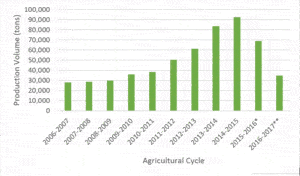 Source: Ministerio de Desarrollo Rural y Tierras, *Media, ** Own Prognosis
Source: Ministerio de Desarrollo Rural y Tierras, *Media, ** Own Prognosis
The implications for the global supply of quinoa are considerable (Figure 2). Bolivia is the second largest producer after Peru, and accounted for 38% of the global production in 2015. Together these countries were responsible for 85% of the production worldwide. In 2016, the harvest in Bolivia and Peru was greatly affected by the climate effects of the phenomenon el Niño. In Bolivia, drought and dust storms caused their production to decrease by 22% to 69,000 tons. And next year a large share of the production will be lost again. Meanwhile the international demand for quinoa continues to grow. This may lead to shortage of quinoa in the global market. We will publish more stories about the supply of quinoa shortly.
Mercadero has been investigating the global quinoa market for several years and initiated a new research project in the summer of 2016. The aim of this research is to gain a thorough insight in the actual supply and demand of quinoa in the world, with the purpose of developing a market forecasting model. In the coming months we will publish articles presenting our findings about the global quinoa supply and demand. Our aim is to generate unique market intelligence and share this with stakeholders in an effort to strengthen this emerging sector in a sustainable manner and benefit producers, exporters and consumers.
- The actual price paid out to farmers, especially for organic certified quinoa, may be higher than the prices indicated here.

